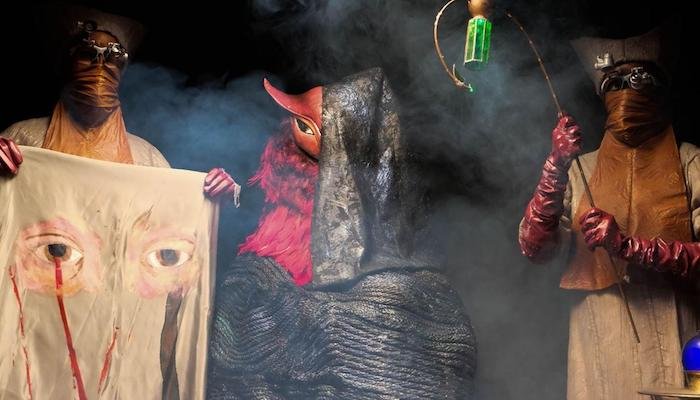I SUDDENLY BECAME AWARE THAT I WAS BOTH MORTAL AND TOUCHABLE AND THAT I COULD BE DESTROYED.
This quote from noted surrealist Leonora Carrington kicks off the proceedings for writer/director Travis Stevens’ new Shudder original movie, A Wounded Fawn. It’s an indicator that while we may start off in the realm of relatively recognizable reality, that’s not where we’ll be staying. The next 91 minutes detail a visually sumptuous journey to the heart of a particularly feminine rage.
A prolog sets up our antagonist, the worldly and deceptively charming Bruce (Josh Ruben). After an auction in which he loses his bid to secure an ancient sculpture of the Furies (vengeful supernatural creatures from Greek mythology), we discover that Bruce is a serial killer haunted by visions of a bizarre humanoid owl creature. Then, we shift gears to follow Meredith (Sarah Lind), a museum curator who has recently gotten out of an abusive relationship. Two brief scenes, one with her therapist and one with her friends, allow us some insight into Meredith’s past and current headspace. We also learn that she has been on a few dates with Bruce and that she’s going to spend the weekend with him at his remote cabin. To go into much more detail would be to ruin some of A Wounded Fawn’s fun.
Stevens wrote the script with Nathan Faudree. It deftly blends the slasher, serial killer, cabin horror, and supernatural thriller genres for an entertaining story that clearly communicates its themes about female empowerment. There are three distinct sections to the film. The prolog establishes our villain and delivers a shock to get us invested. Acts one and two are delineated with onscreen title cards. The first builds tension and Stevens’ direction effectively makes us uncomfortable as we watch Meredith grow increasingly unnerved. The second toss us through the looking glass onto the path of bloody and disturbing retribution.
Performances are solid. There is a small handful of supporting roles (Mailin Barr, Katie Kuang, Neal Mayer, and Nikki James all turn in fine work), but the meat of the film belongs to Ruben and Lind. Ruben impresses as he walks the tightrope between wearing a believable mask of sanity and an unhinged monster. Lind quickly gains our sympathies and directs our hope, fear, and anger in turn.
Ksusha Genefeld’s photography makes for a visually engaging experience. I was a bit concerned when I saw that the film had that artificially distressed faux grindhouse look that has been somewhat overused recently, but thankfully it’s not overwhelming. The palette is desaturated but flat and lurid, nodding again toward grindhouse sensibilities. Compositions, on the other hand, are thoughtful and arty. This contrast makes for a nice tonal accompaniment to Stevens’ tight direction and overall storytelling. My favorite scene occurs in the car on the way to the cabin. The new couple is asking each other questions about their respective pasts and as they pass through a tunnel, we cannot see Bruce’s face, as his silhouette is barely visible against the driver’s side window. It’s a masterful shot that’s moody, generates tension, and comments on narrative themes.
The production design is gorgeous with all of the sets being convincing and grounding. Costumes and creature makeup/designs are inspired and cool. Despite the surrealist aesthetic, the visuals have just enough realism to carry weight. I wouldn’t say this is a splatter flick, as much of the horror is of the psychological bent, but there’s a decent amount of convincing gore. The score by Vaaal is creepy but unobtrusive.
Righteous fury is palpable in Travis Stevens’ A Wounded Fawn. The gruesome and unflinching shot that plays underneath the end titles punctuates that notion. That being said, I wouldn’t describe the film as being in your face. It’s much more matter-of-fact as it drags us through the blood and muck. You’ll be able to catch it on Shudder beginning on December 1st. A Wounded Fawn is recommended for fans of the original Suspiria, Soavi’s Stagefright, and Pan’s Labyrinth.
Michael Cavender





